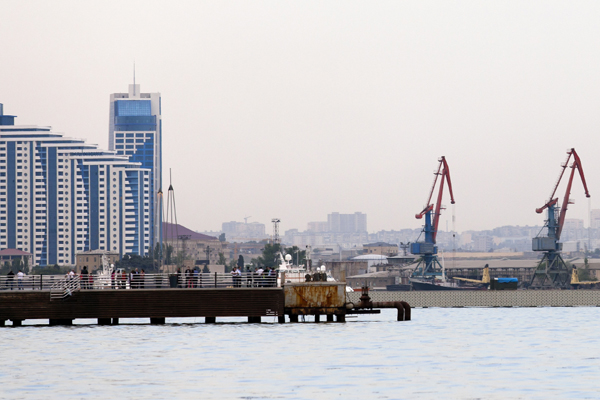Oil and urbanism in Baku

Baku, Azerbaijan, sits upon vast oil deposits on the Caspian Sea. Giant oil derricks can be spotted from the center of the city, which houses 2 million people.
An oil boom in Baku in the early 20th century, says Ivan Rupnik, an assistant professor of architecture in the College of Arts, Media and Design at Northeastern, defined much of the city’s urban design.
During this period, wealth generated by the city’s production of roughly one-fifth of the world’s oil output, he says, spurred the creation of avant-garde buildings, theaters and even one of the first schools for girls in Central Asia.
“Baku’s oil economy led to the construction of cultural buildings in a modified Art Nouveau and a unique cosmopolitan culture,” Rupnik explains. “The city had transformed into a melting pot, attracting professionals from all over the world.”
But this particular moment of cultural prosperity was short-lived, ending with the October Revolution in 1917. Three years later, in 1920, Baku became part of the Soviet Union, and did not regain independence until 1991, following the Soviet’s collapse. Over this period of time, oil fields were nationalized, oil barons were driven out and the city’s architectural focus shifted from extravagant cultural institutions to monumental governmental buildings and multi-unit housing for oil workers.
Rupnik, who has thrice visited Baku, is currently working on an architectural study of the relationship between oil and urbanism in the city from the beginning of the 19th century to the present day. He is collaborating on a forthcoming book on the topic with Eve Blau, a professor of architectural history in the Graduate School of Design at Harvard University, and Sasa Randic, the principal architect at Randic and Associates, who has practiced in Baku.
“We are interested in developing a methodology for how to understand the relationship between oil and urban identity as both a positive and negative reality,” says Rupnik, who has gathered information for the book through site visits, archival research and discussions with architects and historians in Baku. “We want to know how nearly two centuries of oil exploitation have impacted such a unique urban culture.”
Azerbaijan’s independence from the Soviet Union, Rupnik says, generated new wealth and spurred a desire among government officials to transform the city’s urban identity. Mass produced apartment blocs constructed by the Soviets between 1950 and 1990, for example, are currently being reclad with local stone and locally-inspired ornamentation.
“People talk about these apartment buildings the way we talk about the make and brand of our cars,” Rupnik says. “They say, ‘I live in a Leningrad’ or ‘I live in a Moscow,’ designating the city where these buildings were first manufactured.”
City officials, he explains, view Baku as a kind of European metropolis, with gorgeous parks, exclusive shopping centers and lavish housing complexes. In some ways, the city has already returned to worldwide prominence, hosting the 57th Eurovision Song Contest in May and submitting a bid in September to host the 2020 Summer Olympics.
As Rupnik puts it, “Baku is a place in the middle of nowhere that desires to be a world city.”
But the primary reason for the considerable optimism — the city’s robust oil industry, which Rupnik calls Azerbaijan’s “major economic driver” — has also been the source of substantial political and environmental problems.
“Think of Baku as an oil swamp,” Rupnik explains. “You find oil wherever you go. It’s a fact of life.”





